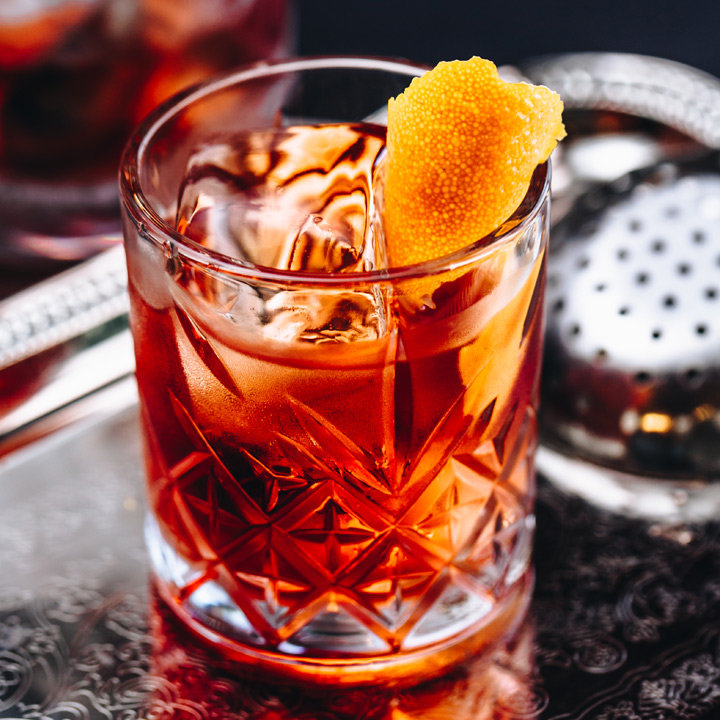
Who can resist a beautiful ruby-hued Negroni?
Apparently, no one. Its Instagram hashtag has well over a half-million posts; it’s the second most sold cocktail in the world for five years running, according to an annual survey by “Drinks International”; spots like New York City’s Dante and Lincoln and Denver’s Bar Helix offer full-on Negroni menus; and it even has its own worldwide calendar slot, Negroni Week, born back in 2013. So maybe it’s time you learn a few things about the Negroni.ho can resist a beautiful ruby-hued Negroni? Apparently, no one. Its Instagram hashtag has well over a half-million posts; it’s the second most sold cocktail in the world for five years running, according to an annual survey by “Drinks International”; spots like New York City’s Dante and Lincoln and Denver’s Bar Helix offer full-on Negroni menus; and it even has its own worldwide calendar slot, Negroni Week, born back in 2013. So maybe it’s time you learn a few things about the Negroni.
1. IT TURNED 100 YEARS YOUNG IN 2019
Happy birthday, Negroni! Yup, this triple-ingredient icon just reached the centenarian mark. “The Negroni was created in Italy, likely in the early 1900s,” says bartender Dylan Knox of Vol. 39 in Chicago. “The story goes, Count Camillo Negroni asked a bartender to strengthen his favorite cocktail, the Americano—created using vermouth, Campari and club soda—and the Negroni was [born].”
2. IT’S AN EASY 3-INGREDIENT COCKTAIL
At its core, the Negroni is about three things: gin, sweet vermouth and Campari—a genius bit of simplicity that also happens to make it a great drink to whip up for happy hour at home. “The Negroni is a classic for a reason,” says Travis Sanders of Pennyroyal and Shaker + Spear in Seattle. “Following the rule of thirds, it’s one of the easiest cocktails to vary and create fun riffs on.”
3. IT HAS LAUNCHED A THOUSAND RIFFS
Or at least dozens. “One of my favorite things to do with avid Negroni drinkers is to see if I can get them to try another drink in the Negroni family tree,” says Xania Woodman, a corporate bartender for Alpine Distilling in Park City, Utah. From old classic drinks, like the Boulevardier (sub bourbon for gin), to new classics, like the Negroni Bianco (bianco vermouth instead of sweet rosso) and the Tegroni (sub in tequila), the Negroni-inspired hits keep on coming. “In winter, I like to infuse my Campari with cacao nibs to add a chocolate layer to the classic bitterness,” says Sanders. “In summer, try using a fun bright amaro instead of the vermouth, such as Brancamenta or Rabarbaro Zucca.”
4. IT’S A DRINK OF EQUAL PARTS—SORT OF
A third, a third, a third—that’s the rule-of-the-thumb recipe to remember for a perfectly standup Negroni. But there’s something about a little extra gin—both the botanicals and the alcohol—that, stirred with ice, further tempers the sweetness of the vermouth, soothes the edges of the Campari and makes the cocktail just a little bit brighter.
5. YOUR GIN MATTERS
Not that you would, but for the love of Count Camillo, don’t use cheap gin. “A Negroni does not necessarily depend on the [gin’s] ingredients or alcohol levels or viscosity. It’s all about the quality of production, which affects the botanicals and overall resulting gin,” says Gary Regan, who recently co-created his own non-chill-filtered version of the spirit, Tod & Vixen’s Dry Gin 1651, with the very Negroni-centric additions of red rooibos tea and makrut lime in a botanical mix. Along those lines, bartenders like Knox also favor a gin with some exotic spice for the drink. “My favorite gin to use is Plymouth. It’s a London dry with a ton of spice, which I love to bridge the gap between the bitterness of Campari and the sweetness of vermouth.”
6. CAMPARI IS A MUST
Sure, there have been a red river of bitter aperitifs flooding the market from the world ’round, but in a classic Negroni, Campari is the bitter of choice. “Campari is my go-to bitter liqueur,” says Regan. “Others can work, but for me, it’s Campari.” The liqueur began production in northern Italy around the turn of the last century, 15 short years before the drink made its initial debut, and while gin and vermouth choices might vary from bar to bar, Campari remains the gold-standard ancestral ingredient to a classic Negroni. “You need Campari for a perfect Negroni,” says Knox. “There are a lot of imitators out there but none nearly as good as the original.”